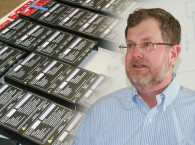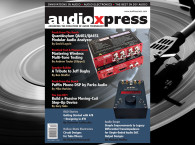
By its very nature, the world of electroacoustics is an interdisciplinary one. Audio practitioners are often involved in varied aspects of the product’s life cycle, from research and development, ideation, design, production test, and service. This constant need for data acquisition involves complex and time-consuming setups and fixtures. In today’s flexible workspaces, access to the sophisticated test and measurement systems required for modern products often presents a resource bottleneck.
So when I first learned about the QA401 audio analyzer, I was intrigued by the value offered. It provides dual-channel FFTs, balanced inputs and outputs, up to 192kHz sample rates, and a -118dBV self-noise. While there are other software solutions in the sub-$500 price point, competitive offerings typically force you to bring your own sound card to the party. The QA401 is a complete standalone system of hardware and software that does not utilize a sound card (see Photo 1).
During my discussions with QuantAsylum, I learned that they are in the process of upgrading one of their key accessory products for this analyzer, so I also requested a pre-production version of the QA451 — a programmable load that easily allows testing of audio amplifiers of up to 300W, thanks to the use of burst mode test signals. The QA451 is the successor to the QA450. The primary upgrades of this hardware companion are improved tolerances, as well as steeper roll-off on the low-pass filter at 34kHz (sixth-order on the QA451 vs. first-order on the QA450).

Standalone Hardware, No Sound Card Needed
Audio test systems fall into two general categories: dedicated hardware or PC sound card-based. When cost is no object, or in large commercial settings, the dedicated hardware system is typically chosen for increased precision. It also better meets calibration and traceability customer requirements. Sound card solutions offer lower cost, increased portability and are often the first solution when a new production test system needs to be deployed and replicated with minimal investment.
It is well known that dealing with Windows audio issues can be problematic, due to the multiple volume mixers or Microsoft updates that can reset gain settings for inputs and outputs. To address these concerns, audio test systems often favor using ASIO-based sound card solutions to prevent audio gain changes that occur when standard Windows audio drivers are engaged. But switching to ASIO sound cards will add further cost to a system that is often a budget-sensitive expense. With standalone hardware, this “pain point” of calibration and setup is eliminated. This is a strong positive usability advantage for the QA401.

Ready Already
In most cases, audio test systems often have a lengthy calibration setup, as well as a manual process where at least once per day, a series of reference “loop back” measurements need to be performed prior to measuring your DUT. It is quite refreshing that the QA401 comes ready to go and calibrated out of the box with both stereo differential inputs and outputs.
The calibration of the system can be further fine-tuned by adjusting the calibration text files and validating them with a known lab-grade DMM or oscilloscope. The system’s actual tolerance is ±0.06 dB. With fine tuning, it is possible to bring that variation down to ±0.02 dB for a single channel. Typically, the factory provided calibration is more than sufficient for most applications.
Mechanicals
The QA401 is a compact audio analyzer. The front panel has stereo differential inputs and outputs, as well as indicator LEDs for PC link, attenuation, and run status (see Figure 1). The back panel has a single USB Type B port and requires up to 600 mA of current, so the use of a powered USB hub is recommended, in case a USB port in your PC is current-limited. The attractive casing is sturdy aluminum with a full color UV printed front panel. There are no buttons, knobs, or switches, as the device is fully controlled by the system software (see Photo 2).
The pre-production QA451 sample is a programmable load that streamlines testing of audio power amplifiers. QA451 I/O is similarly streamlined, with indicators, load inputs, single-ended outputs, and current sense on the front panel. The back panel has a single USB port with a current draw of under 500 mA.

Basic Measurements and GUI
The QA401 offers four primary measurements: RMS/Power, THD/THD+N, SNR, and Frequency Response. These are all accessible under the “Measurements” panel in the QAAnalyzer software package.
From inspection of the application GUI, it is readily apparent that the software architecture is focused on delivering results in an uncluttered, well-organized and deliberate fashion. Distinctively, the menu bar is not the key method to drive and control the application. Instead, controls are contained within a graphical panel on the right side of the screen.
From this interface, the end user can select display and axis settings, as well as choose basic tests, filter windows and weighting, signal generators, and the attenuator level. When there are more user options, this is denoted with a dot on the relevant button (see Figure 2). To access these context menus, simply long press or control-click the button to make the necessary changes to the submenus. Updates are reflected in the display area on the top of screen.
Interestingly, the program eschews keyboard shortcuts, in favor of this embedded contextual menu approach. Checking the documentation, I noted that there are only six keyboard shortcuts available within the application, for things such as adding markers to the display or pressing the Run/Stop button. While different than many Windows apps, after a brief acclimation period, it becomes quite simple to navigate and operate like a pro.
Exploring the menu bar, you will find the intriguing Test Plugins section. This provides access to advanced setups, streamlines processes, and offers production-ready automation tools. Rapid access to tests such as THD vs. SPL, amplifier gain vs. distortion, microphone comparison, or even speaker rub and buzz offers a myriad of options for electroacoustic testing.
Additionally, QuantAsylum has released an open-source application called Tractor that allows typical test lists to be executed and logged, without the need to write any code or scripts. It is as simple as just adding tests from pull-down menus and arranging the necessary order of operations (see sample in Figure 3). If you do need to add a new test, source code is publicly available, and you can build the needed .DLL files using Microsoft Visual Studio.
Another added benefit of Tractor is that data can be logged as a simple .html file. Data can be stored locally, or QuantAsylum also provides free cloud access and storage of your data—permitting you to post-process and analyze your test results as you further refine your production test methods.

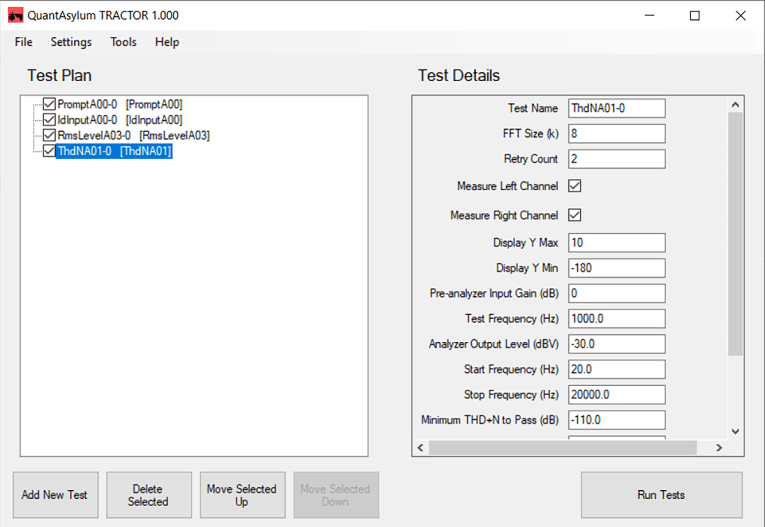
Solutions to Go
Since 2015, when QuantAsylum released its first audio analyzer, its product offerings have been quite distinctive and full-featured. Traditionally, audio measurement software is often distributed in three tiers of increasing cost: basic, advanced, and quality control. The engineers at QuantAsylum have chosen a more impactful model and instead provide all three software tiers free with the hardware, freeing use, which has the added benefit of not limiting user contributions due to arbitrary constraints.
In addition to expediting production test software and methods, QuantAsylum offers additional hardware tools to enhance and simplify hardware setups. The QA451 is a programmable load (4Ω or 8Ω) and can support up to 300W in short bursts of 300 ms. Key features include full isolation from the PC, thermal-protection, a built-in 12 dB attenuator, and a sixth-order active low-pass filter at 34 kHz to keep any power supply switching noise out of your measurements. Manual control of the device is easy via the QA451 mini-app, or there is full support using the REST interface from your preferred development language, if you choose a highly customized web-based solution.
In addition to the QA451, other specialized hardware accessories available from QuantAsylum include a microvolt DC voltmeter, a transducer driver for measuring Thiele-Small parameters, a low-noise mic preamp, and a high-side current sense amplifier.

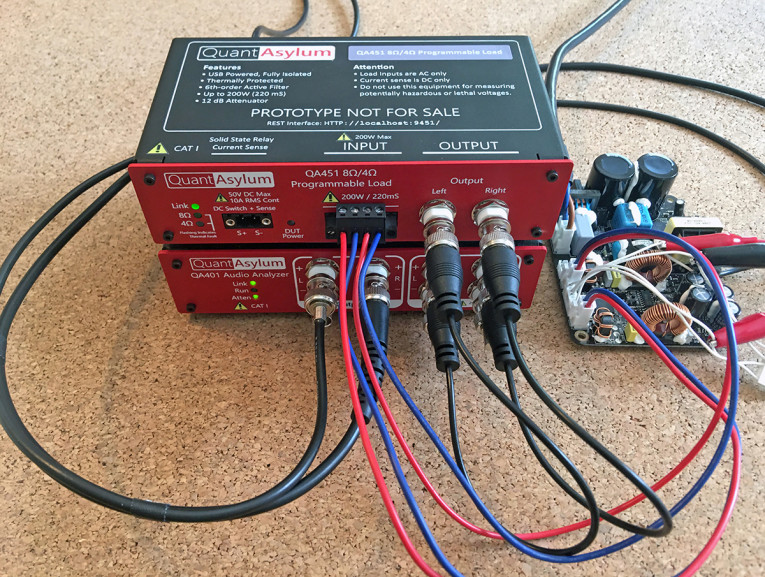
First Look
For initial testing, I chose to measure a spare Class D amplifier, the venerable ICEpower 50ASX2SE. This is the single-ended stereo version, which delivers 2× 50W into 4Ω. As it has been in storage for a number of years, I decided that three suitable tests to verify performance would be measurements of gain, frequency response, and THD+N. As this runs off mains AC and does not use an outboard DC power supply, the current sense feature of the QA451 cannot be used. In Photo 3, the DUT setup for the ICEpower module and connections to the QA401 and QA451 are shown.
I measured the gain using the RMS/Power measurement feature. Results are shown in Figure 4. Next, I measured the full-range frequency response via the AMP FrequencyResponseChirp. Finally, I measured THD+N using the Test Plugin PWR THD vs. Output Power (see Figure 5 and Figure 6).
Next, I tested another Class D amplifier, the Fosi Audio TDA7498E Class D Amp (2× 165 W). This unit uses an external DC power brick (24 V × 4.5 A), so the current sense features of the QA451 are relevant here and will be highlighted. The setup is shown in Photo 4. The QA451 software panel (see Figure 7) conveniently provides the current draw of the DUT as well as thermal monitoring on the load resistors, ensuring that test cycle time can be properly optimized. For this device, I measured the amp self-noise, THD vs power, and frequency response into both a 4 Ω and an 8 Ω load (see Figure 8).



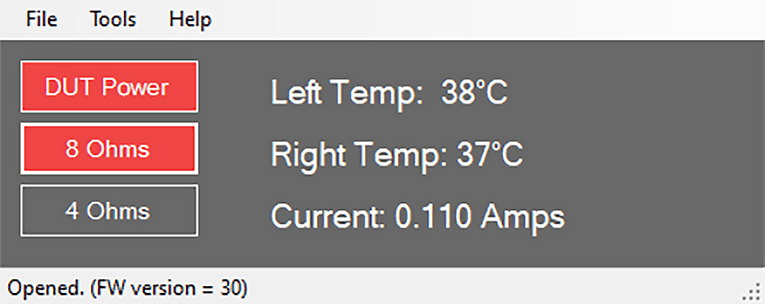
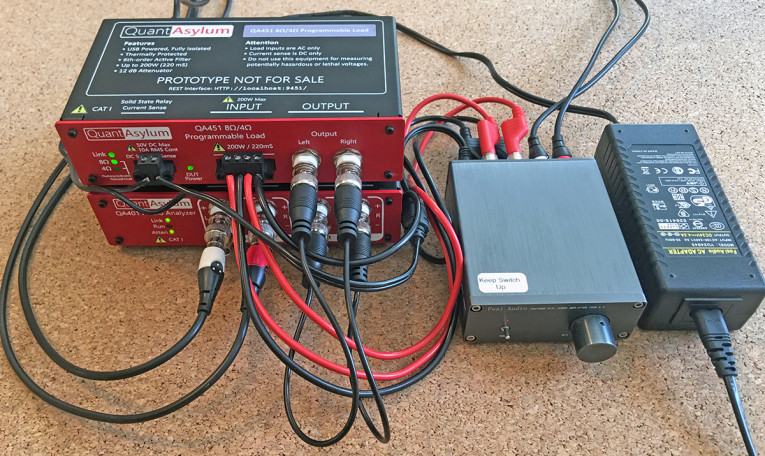
Test Plans in the Cloud
As previously mentioned, QuantAsylum has provided a free open-source software tool called Tractor, dedicated to easily executing automation test plans. In Figure 9, a sample test plan that I constructed is shown. No code or scripting is necessary (although source-code is publicly available on GitHub if you are interested in deep customization). Creating the plan only requires the user to press the Add New Test button, select the appropriate test and setting, and then adjust the desired execution order.
Data logging options are surprisingly rich. Test data can be saved in .csv format for ease of post-processing, exported to a corporate SQL server, or even stored on a free Cloud database that QuantAsylum provides to its customers at no charge. The myriad options offer great flexibility for manufacturers large and small, especially those looking at enhancing their data and production record keeping needed for audit or certification purposes. One further bonus, is that the cloud database already provides typical statistical analysis, calculating and logging the mean and standard deviation values automatically. If you require more sophisticated analysis, then simply download and post-process the data as needed.

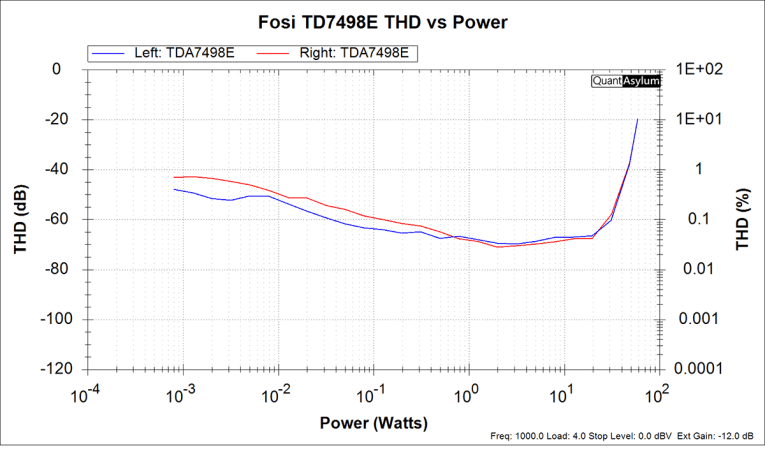
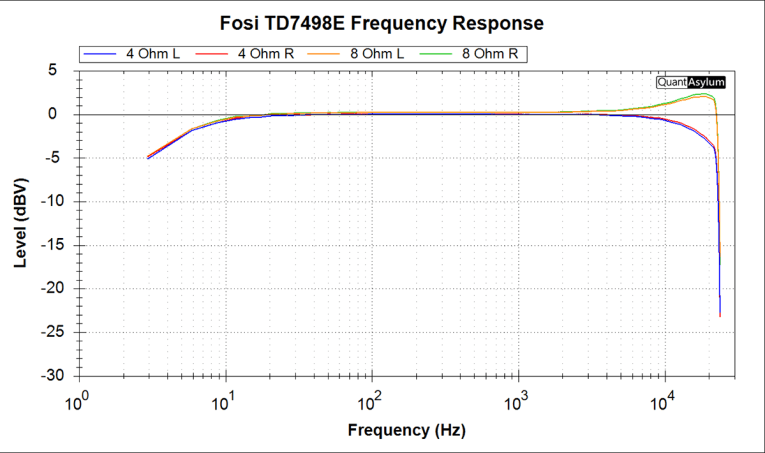
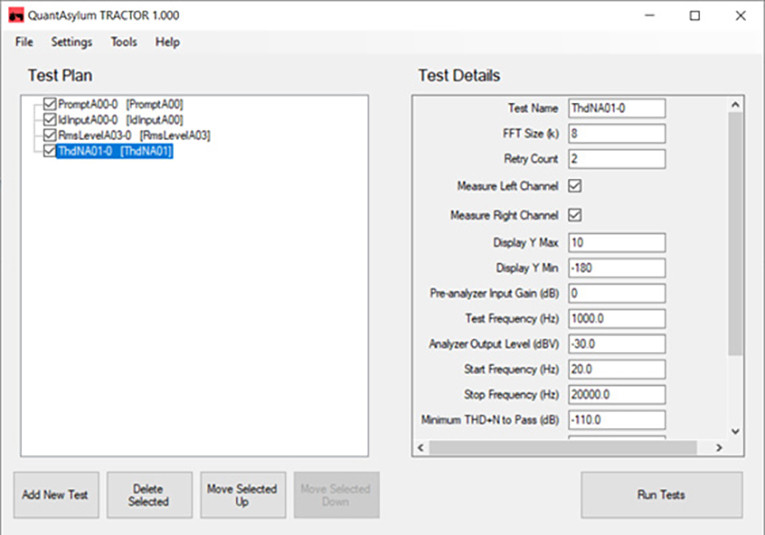
Comparison on Automation—Take a REST, Ride a Tractor
If you plan on using the QA401 and the QA451 in a production environment, there are a plethora of tools available right out of the box, from easy scripting options, to simple “point and click” GUI options, plus modifications to the open-source code for the core applications, if you want to go for a truly customized and unique build.
When the product you are testing has non-audio functions, it could prove useful to utilize a standard programming or scripting language so that the QuantAnalyzer can be integrated into a fully-automated test program. The QA401 and QA451 both support the Representation State Transfer (REST) protocol for control over a web-based interface. To investigate this functionality, I first downloaded the “headless” (i.e. non-graphical) version of the QA401 software, in order to interact via a Command Line Interface (CLI).
Once I installed that package, I opened a Command Prompt in Windows 10 and enabled a “listening session” over the USB prompt and the headless control software. Next, I opened a FireFox window with a REST extension enabled and began entering the various control parameters using the standard functions over the web interface with commands such as PUT, GET, and POST (see Figure 10).

Final Thoughts
Ordinarily, audio laboratories are filled with dedicated hardware for measuring all manner of electroacoustic parameters. It is atypical, however, for the ratio of gear to engineers to be 1:1. That means there is often a backlog or wait list for access to lab equipment. For critical measurements for data sheets or characterization before sending a sample out to customer or certification, the proper paradigm is the utilization of the dedicated hardware systems.
But if you need to check a new sample and provide same-day feedback, or make measurements in the field or a home office, then the opportunity to have an audio test system in the cubicle or desk of every engineer becomes compelling. This appears to be the raison d'être of the QA401 and the QA451.
These are powerful and compelling tools that enable and accelerate the development process. In a world of increasing measurement demands, decentralizing the test platforms and deploying them throughout a team is a positive productivity enhancement. And while a lab full of dedicated analyzers and instruments is still a must, getting more tools out to all of the team members is a recipe for organizational success.
Whether a development engineer needs to quickly address the latest iteration of a new power amplifier, or a production engineer needs to develop and scale a production-ready test solution without the support of a software and firmware team, the combination of the QA401 and the QA451 offer enticing capabilities.
From the core application functionality to the availability of Test Plugins, production tools for automation, and free cloud storage for data access, the combination of the QA401 and the QA451 resonate with a satisfying sense of cohesion, thanks to the well-rounded system-level architecture and product support. Too often, test and measurement are not given the attention that they deserve in corporate environments, due to the common constraints of time and money.
This problem is particularly notable on the production test floor, where speed, accuracy, and cost are the critical factors, beyond any advanced capabilities that might be needed for product design, development, or troubleshooting. If you are looking to save money, minimize setup times, and remove obstacles to shared resources in the laboratory and production environments, QuantAsylum has developed an impressive toolbox of hardware and software. aX
This article was originally published in audioXpress, December 2020
QA401 Audio Analyzer
QuantAsylum USA LLC
7829 Center Blvd SE #225
Snoqualmie, WA 98065
www.quantasylum.com
List Price: $449
QA451 Programmable 8 Ω/4 Ω Load
List Price: $289
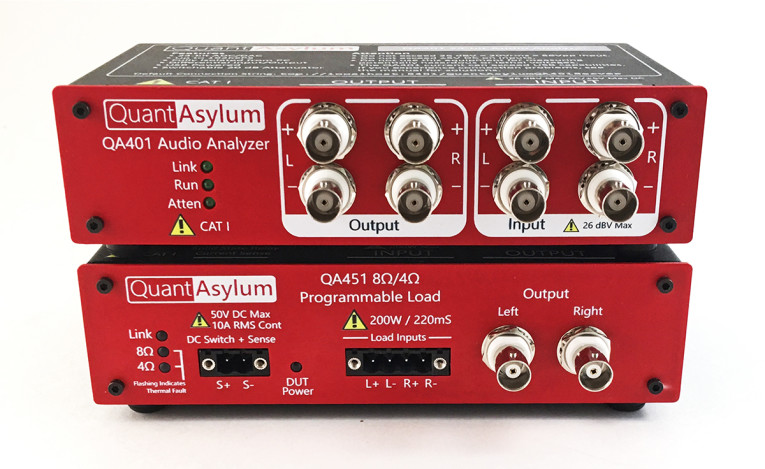
Resources
“QA401 Quick Start,” QuantAsylum,
https://cdn.shopify.com/s/files/1/1631/5609/files/QA401_Quick_Start_RevB.pdf?v=1588785095
“QA401 Product Brief,” QuantAsylum,
https://cdn.shopify.com/s/files/1/1631/5609/files/QA401_Product_Sheet_RevD.pdf?85
“QuantAsylum QA401 User’s Manual,” QuantAsylum,
https://cdn.shopify.com/s/files/1/1631/5609/files/QA401_Users_Manual_0ea33c5f-a8c5-449a-92d3-7927893485a9.pdf?v=1588785336
“QuantAsylum QA450 User’s Manual,” QuantAsylum,
https://cdn.shopify.com/s/files/1/1631/5609/files/QA450_User_s_Manual.pdf?12998937473040546318
“QuantAsylum QA450 Product Sheet,” QuantAsylum,
https://cdn.shopify.com/s/files/1/1631/5609/files/QA450_Product_Sheet_RevB.pdf?4450960313629741042
“Introducing the QA451,” QuantAsylum (July 22, 2020 blog post),
https://quantasylum.com/blogs/news/introducing-the-qa451?_pos=3&_sid=c3e3f6935&_ss=r
“QA401, REST, and Python,” QuantAsylum (May 17, 2019 blog post),
https://quantasylum.com/blogs/news/qa401h-rest-and-python?_pos=1&_sid=2936e996c&_ss=r
“Automated Amplifier Testing with Tractor,” QuantAsylum (April 20, 2019 blog post),
https://quantasylum.com/blogs/news/automated-amplifier-testing?_pos=2&_sid=92631868a&_ss=r
“QA401 Headless & Linux Support,” QuantAsylum (December 6, 2018 blog post),
https://quantasylum.com/blogs/news/qa401-headless-linux?_pos=1&_sid=c557a7254&_ss=r
“First Look: Evaluating Class D Power Amps with the QA401,” QuantAsylum (April 30, 2016 blog post),
https://quantasylum.com/blogs/news/first-look-evaluating-class-dpower-amps-with-the-qa401?_pos=1&_sid=f13498c85&_ss=r
 About the Author
About the AuthorDavid Logvin is an acoustics engineer at TDK InvenSense, working in the MEMS microphone division. With more than 20 years of experience, he has designed loudspeakers and other products for Snell Acoustics, Outlaw Audio, ClearView Audio, Cambridge Sound Management, and others. During his 14 years at Snell Acoustics, he developed and designed dozens of high-end loudspeakers and amplifiers, as well as helped to create loudspeaker standards in close collaboration with THX. David then focused his efforts on R&D, creating innovative, award-winning piezo-driven membrane loudspeakers with ClearView Audio (formerly known as Emo Labs). At Cambridge Sound Management, he put his skills in room acoustics to use in the field of sound masking for corporate applications. Most recently, he rejoined his fellow Snell Acoustics alumni, Dr. Joseph D’Appolito, to design several new loudspeakers for Outlaw Audio. In addition to his lifelong love of music and acoustics, David is an active participant in the Boston tabletop game design community. He is a member of the Audio Engineering Society (AES) and the Boston AES Section and lives in Lowell, MA with his family.




